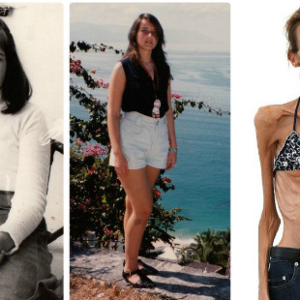Lactose intolerance is more widespread than many realize, yet its symptoms often go undiagnosed or misattributed to other health issues. While digestive discomfort is the most commonly recognized sign, lactose intolerance can also manifest in unexpected ways, affecting the skin, energy levels, and even mental clarity.
Could lactose be the hidden culprit behind your persistent discomfort? Here are eight surprising signs that your body might be struggling to digest dairy.
1. Skin and Nail Problems: A Hidden Link to Dairy

Skin issues like dryness, persistent acne, or eczema-like rashes may indicate lactose intolerance. Some people also experience brittle nails that break easily or grow unevenly, signaling poor nutrient absorption due to difficulty digesting dairy.
Why Does This Happen?
When the body struggles to break down lactose, it can impair the absorption of essential vitamins and minerals like:
- Calcium – Important for strong nails and healthy skin.
- Vitamin D – Essential for skin repair and immune function.
- Zinc – Helps prevent acne and inflammation.
If you suffer from chronic skin irritation or weak nails, cutting back on dairy might improve these symptoms.
2. Unexplained Swelling: A Surprising Reaction
Swelling, particularly around the face, lips, or eyes, can be a sign of an immune reaction to dairy proteins. Some people mistake this for seasonal allergies, when in reality, lactose intolerance or dairy sensitivity could be to blame.
Symptoms That May Indicate Dairy-Related Swelling:
- Puffy face in the morning after consuming dairy at night.
- Hives or red patches on the skin.
- Tightness in the throat or difficulty swallowing.
In severe cases, throat swelling and difficulty breathing could indicate an anaphylactic reaction, which requires immediate medical attention.
3. Persistent Bloating: The Classic but Overlooked Sign
Bloating is one of the most common yet overlooked symptoms of lactose intolerance. If you frequently feel bloated after consuming milk, cheese, or ice cream, your body might be struggling to digest lactose efficiently.
Why Does Dairy Cause Bloating?
When lactose isn’t properly broken down, it moves into the colon, where gut bacteria ferment it, producing gas. This leads to:
- A swollen, uncomfortable belly
- Excessive gas and discomfort
- Feeling “full” even after small meals
If bloating is consistent and worsens after consuming dairy, it may be time to explore lactose-free alternatives.
4. Excessive Flatulence: A Sign of Fermentation
Frequent gas can be an embarrassing but telling sign of lactose intolerance. When the body fails to break down lactose in the small intestine, it ferments in the colon, producing gases like methane, hydrogen, and carbon dioxide.
Key Indicators That Dairy May Be the Cause:

- Gas occurs within 30 minutes to 2 hours after consuming dairy.
- The smell is stronger than usual due to bacterial fermentation.
- Accompanied by cramping or an urgent need to use the restroom.
Eliminating dairy for a few weeks and monitoring gas levels can reveal whether lactose intolerance is at play.
5. Mouth Ulcers: An Uncommon but Possible Symptom
Frequent mouth ulcers or canker sores might be linked to dairy sensitivity. While not a widely recognized symptom, some experts believe proteins in cow’s milk may trigger an inflammatory immune response in certain individuals.
Signs Dairy Might Be Causing Your Mouth Sores:
- Ulcers appear shortly after consuming milk, cheese, or yogurt.
- Sores recur frequently, despite good oral hygiene.
- Eliminating dairy reduces the number of outbreaks.
If you frequently suffer from mouth sores, switching to plant-based dairy alternatives (like almond, oat, or soy milk) may help.
6. Digestive Discomfort: Diarrhea or Constipation
Lactose intolerance doesn’t always cause diarrhea—it can also lead to constipation in some individuals.
Why Does This Happen?
- Diarrhea: The undigested lactose pulls excess water into the intestines, leading to loose, watery stools.
- Constipation: Some individuals produce methane gas, which slows intestinal movement, causing hard stools and difficulty passing waste.
If your bowel habits change significantly after consuming dairy, it may be a sign that your body is struggling to process lactose.
7. Headaches and Fatigue: The Unexpected Connection

Lactose intolerance can also affect your energy levels and mental clarity. Some individuals report feeling fatigued, foggy, or experiencing headaches after eating dairy products.
Potential Reasons Dairy Might Cause Fatigue:
- Inflammatory response – Some people’s bodies react negatively to dairy, leading to chronic fatigue and sluggishness.
- Blood sugar fluctuations – Dairy products can cause insulin spikes, leading to energy crashes.
- Poor gut health – When the gut struggles to digest lactose, it can impact nutrient absorption, making you feel tired and unfocused.
If you experience brain fog or unexplained exhaustion, try cutting dairy for two weeks to see if your energy levels improve.
8. Abdominal Cramps and Pain: A Clear Warning Sign
One of the most painful symptoms of lactose intolerance is abdominal cramping. This occurs when undigested lactose ferments in the colon, causing intestinal spasms and discomfort.
How to Recognize Dairy-Induced Stomach Pain:
- Sharp, twisting pains that appear 30 minutes to 2 hours after eating dairy.
- A gurgling or rumbling sensation in the stomach.
- Pain relieved after passing gas or having a bowel movement.
If dairy consistently leads to stomach pain, your body may be struggling to process lactose properly.

Final Thoughts: Is It Time to Cut Back on Dairy?
Lactose intolerance is more than just a minor inconvenience—it can impact your skin, energy, digestion, and overall well-being. If you recognize multiple symptoms from this list, it may be time to experiment with a dairy-free diet.
What You Can Do Next:
Try eliminating dairy for 2-3 weeks and monitor your symptoms.
Switch to lactose-free or plant-based alternatives like oat milk, almond milk, or coconut yogurt.
Speak to a doctor or nutritionist to explore lactose intolerance testing.
Your body might be trying to tell you something—are you listening?


